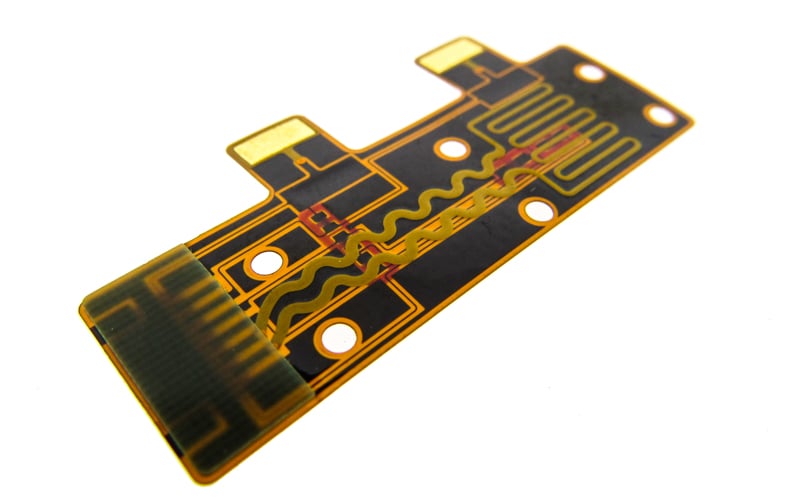The most important, most critical, and among the most helpful of all documents for building and designing flex and rigid-flex circuits is IPC-6013.
IPC-6013 is the “Qualification and Performance Specification for Flexible/Rigid-Flexible Printed Boards”, a standard that dictates the elements and features of different classifications of flexible and rigid-flex circuits. The current revision is revision E, updated as of September 2021. Within this revision, it outlines many topics, enough to cover 84 pages.
Among these topics, some of the best things to know are how IPC classifies types of flexible boards by layer count and installation usage, plating requirements of flex circuits, and quality requirements.
Flexible Circuit Board Classifications Per IPC
For IPC classifications, there are three different primary ways a circuit board is classified. First are the performance classes. This determines the amount of stringency a board must undergo for quality and the importance of end-use cases. While IPC-6013 does not touch on the definitions of performance classes and relinquishes that duty to IPC-6011, it does still touch on the difference of the performance classes for both requirements and for quality concerns.

Example of a double-sided flexible PCB.
The second way a board can be classified is by the printed board type. These can fall into 5 types, which dictate the complexity of the board.
- Type 1: Single-sided flexible printed boards containing one conductive layer, with or without stiffeners.
- Type 2: Double-sided flexible printed boards containing two conductive layers with PTHs, with or without stiffeners.
- Type 3: Multilayer flexible printed boards containing three or more conductive layers with PTHs, with or without stiffeners.
- Type 4: Multilayer rigid and flexible material combinations containing three or more conductive layers with PTHs.
- Type 5: Flexible or rigid-flex printed boards containing two or more conductive layers without PTHs.
The final classification of a circuit board relies on its’ installation characteristics. These typically involve how they are bent and the environment they are placed in. As seen below, these uses are classified by letters A through D.
- Use A: Capable of withstanding flex during installation.
- Use B: Capable of withstanding continuous flexing for the number of cycles as specified on the procurement documentation.
- Use C: High temperature environment (over 105 °C [221 °F]).
- Use D: UL Recognition. See UL 94 and UL 796F.
These are the least commonly used classifications; however, they can affect the stack-up and material choices.
Plating Requirements
When it comes to flexible circuits, plating becomes much different than that of rigid circuit boards. For example, the primary method of plating for plated through holes in flex circuits is known as ‘button plating’ or ‘pad plating’, a method that involves only plating the surface pad and the hole, rather than the entirety of the surface of the board. As a result, the plating requirements of a flexible or rigid-flex circuit are much less than that of a rigid circuit board.
| Surface And Hole Copper Plating Minimum Requirements For Through-Holes | |||
|---|---|---|---|
| Copper - Average | Class 1 | Class 2 | Class 3 |
| Type 2 | 12 μm (472 μin) | 12 μm (472 μin) | 12 μm (472 μin) |
| Type 3 and 4 except as noted below | 25 μm (984 μin) | 25 μm (984 μin) | 25 μm (984 μin) |
| Type 3 and 4 greater than 1.5mm [0.059 in] thickness and has low Tg materials less than 110 °C in the areas of the board spanned by PTHs | 35 μm (1378 μin) | 35 μm (1378 μin) | 35 μm (1378 μin) |
| Copper (Min. Thin Areas) | |||
| Type 2 | 10 μm (394 μin) | 10 μm (394 μin) | 10 μm (394 μin) |
| Type 3 and 4 except as noted below | 20 μm (787 μin) | 20 μm (787 μin) | 20 μm (787 μin) |
| Type 3 and 4 greater than 1.5mm [0.059 in] thickness and has low Tg materials less than 110 °C in the areas of the board spanned by PTHs | 30 μm (1181 μin) | 30 μm (1181 μin) | 30 μm (1181 μin) |
| Minimum Wrap | AABUS | 5 μm (197 μin) | 12 μm (472 μin) |
| Minimum Wrap | AABUS | 5 μm (197 μin) | 5 μm (197 μin) |
As shown in the previous section, this table references the various plating requirements for the different types of flex and rigid-flex PCB designs. While this table does hold the plating requirements for through holes, there is another table dedicated to just blind and buried vias and their plating requirements. In addition, there are plating tables for things such as micro-vias and buried via cores.
Quality Requirements
Many of the quality requirements for flex and rigid-flex PCBs retain similarities to their rigid PCB counterparts. A good example of the similarities is how PTH, microvias, and internal plated holes share similar breakout requirements between both specifications. This, alongside conductor quality requirements, copper weight tolerances, and many other items are all incredibly similar between both standards.
However, there are some key differences. For instance, with flex and rigid-flex circuit boards, bow and twist aren’t an entirely useful measurement, due to the inherent flexible nature of flexible materials. In this case, bow and twist only apply to rigid sections of rigid-flex circuit boards.
Another key difference lies in that certain elements of flexible boards are inherently different, such as coverlay, stiffeners, and adhesives. Due to these materials, portions of the standard cover items such as soda strawing (lifting of coverlay around a trace, an acceptable condition), creases in coverlay films (an acceptable condition if delamination does not occur), or foreign materials under stiffeners if they do not cover more than 5% of the stiffener area.
Summary
One of the most valuable tools for designing and manufacturing flexible and rigid-flex circuit boards lie with IPC-6013. Among the most important things to know are the classifications of circuits, the plating requirements, and the appropriate quality requirements that would impact a design. However, there are too many things to list that could impact a design within the document.
While IPC-6013 is an important tool, there are items within it that may not apply to all designs. In situations where there are questions about a requirement, it is best to contact the manufacturer for clarification if it applies to your design.
Key Takeaways
- IPC-6013 classifies flexible PCBs by type and installation usage: Flexible circuit boards are classified into five types based on layer complexity and construction, as well as four usage classes depending on flex requirements and environmental conditions.
- Plating requirements for flexible PCBs differ from rigid boards: Unlike rigid PCBs, flex circuits primarily use ‘button plating’ or ‘pad plating,’ where only the surface pad and plated through holes (PTHs) are coated rather than the entire board surface.
- Quality standards for flex PCBs share similarities with rigid PCBs but have key differences: While many requirements like conductor quality and copper weight tolerances are consistent, flex-specific elements such as coverlay integrity, stiffeners, and acceptable defects like soda strawing and creases are unique to IPC-6013.
- Bow and twist measurements apply only to rigid sections of rigid-flex designs: Since flex circuits naturally bend, traditional board warpage measurements are relevant only to the rigid portions of a rigid-flex PCB.
- Consulting IPC-6013 is crucial for designing flex and rigid-flex PCBs: While the specification provides essential guidelines on classifications, plating, and quality requirements, consulting a PCB manufacturer is recommended for clarifications on design-specific requirements.
















